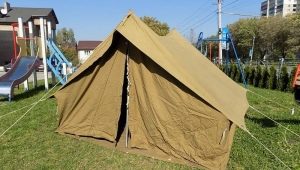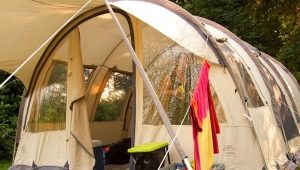Winter tents "cube" for fishing: types, recommendations for selection and use
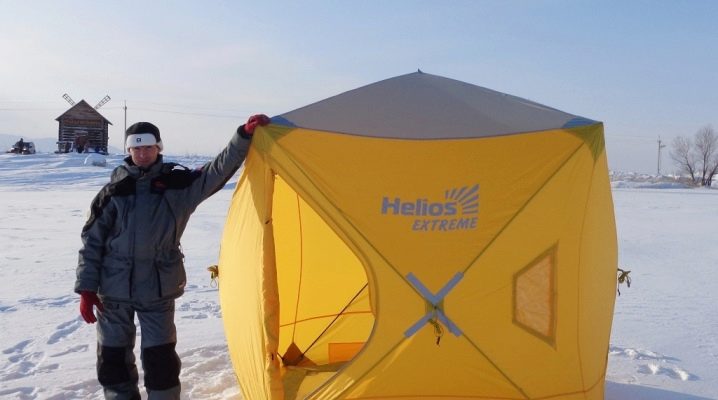
Basically, cube tents are suitable for winter conditions. Tightness, wind resistance and comfort - this is about them.


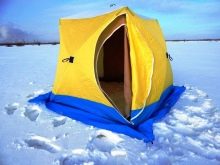
Peculiarities
The advantages of cubic tents include spaciousness, speed of deployment, multi-layered execution and comfort when parking, spending the night in such a mobile room.
The dimensions of the tent make it possible to catch fish at the same time by several fishermen. The tent has dimensions that allow fishermen, along with the equipment necessary for successful fishing, to be placed inside the tent, without particularly restricting each other's actions. A tourist or a fisherman has the opportunity not only to lie or sit in such a tent, but also to stand straightened up to his full height.
In the "cube" it is possible to safely and efficiently place a stove or burner, which cannot be said about an umbrella-type tent.
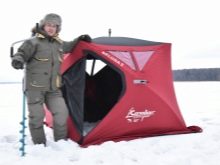


Despite the apparent bulkiness of the already installed tent, the “cube” is assembled in a maximum of a few minutes.
The walls and ceiling of the tent smoothly bulge outward - this allows people to accommodate most effectively. In a single or double tent, one person will spend the night comfortably.
It fits in a special bag or case and is convenient to carry, it can be transported in a city bus without fear that it will fall into the category of oversized cargo.

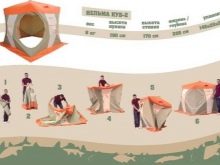
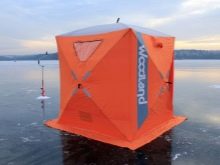
Comparison with umbrella tents
In an umbrella-type tent, a person with things also fits freely, but in order to stand up to his full height, you need to move to the center, under the top of the dome. "Cube" frees the fisherman or tourist from such a need. But this is where the virtues of the "cube" end.
- The "umbrella" tent is warmer than the "cube". In it, in order to heat all the air inside from the same heat source, you need to spend more time and fuel.
- "Umbrella" is much more wind-resistant due to its external streamlining. The “cube” will resist strong winds, which will require not less than 4, but not less than 6 anchors or pegs to fix it on the ice of a reservoir or on the ground.
- "Umbrella" is definitely faster than the "cube" in the assembly. To understand this, look at the cheapest umbrella-type tent. Here, the design of the "umbrella" includes only a pair of long crossed guides made of flexible and resilient material (for example, fiberglass).

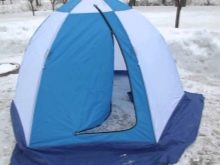
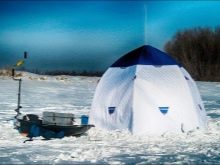
A small "umbrella" tent is an almost perfect solution for solo fishing tasks.
Savings - on the cost of the tent itself. It happens that a lone fisherman uses a two- or three-person umbrella to make it easier for him to stand up to his full height without leaving the tent, especially when he could not find an inexpensive “cube” in the nearest stores, and there is not enough time to wait for the cubic tent to be sent or patience.
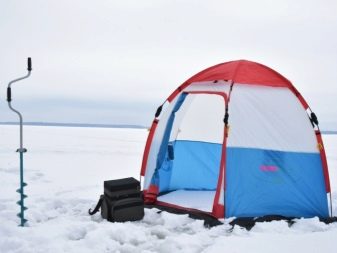

Varieties
According to the number of layers of matter, tents of the "cube" type are divided into one-, two- and three-layer.
Single layer
Single layer tents do not have additional layers. The same awning protects from bad weather. But it will not retain heat - you are in direct contact with the frozen tent.In addition, condensation quickly forms inside, which, if not dried in time, will turn into room rain. An example is single layer tents. "Premier Cube 1.8".
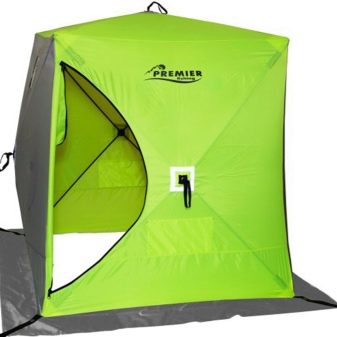

Double layer
A two-layer tent of the "cube" type has the following structure: the roof and ceiling are sheathed on the outside with a waterproof fabric with water-repellent impregnation. The ceiling is made of breathable semi-synthetics, double waterproof fabric is used on the door and walls, and the floor consists of reinforced water-repellent fabric.
The product also protects against drafts. And although it already has an air gap between the inner and outer matter (better than direct air contact in a tent with a supercooled outer tent), but the insulation in it is not the best. The internal temperature will be 3-4 degrees higher than outside, and you cannot do without a heater in cold weather. As an example - the tent "Beach Cube 1.8".
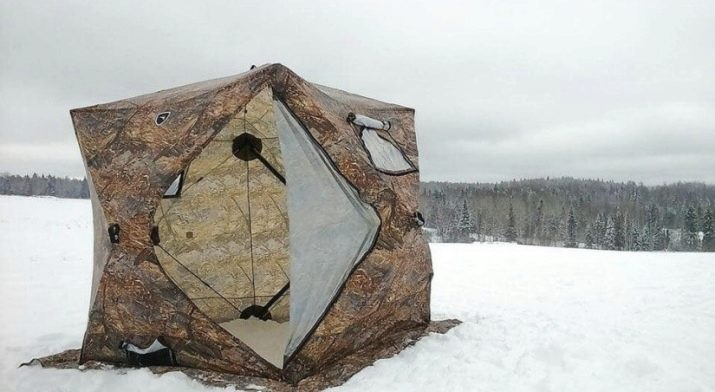
Three-layer
In three-layer tents, the top layer is an Oxford fabric that does not allow moisture to pass through, the middle layer is a quilted padding polyester (thermal tie) and the inner layer is any breathable or semi-breathable fabric. As a result, not one heat-saving air layer is formed, but two.
The three-layer tent is insulated: it is suitable for harsh Russian winters. According to the reviews of the same fishermen and year-round northern hikers, the temperature inside can be up to 9 degrees higher. So, if it is -10 outside, it will be -1 in a tent without heating. If in the off-season or during the cool northern summer the thermometer outside showed, say, +13, inside it will be quite room temperature - 22 degrees Celsius. In order not to suffocate in a dream in such a tent, additional covered openings are provided, which use microventilation during showers.For example, fishing "Penguin Prism Thermolight" Russian production.
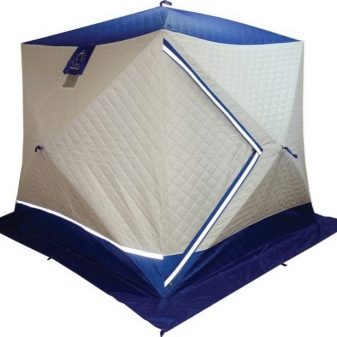
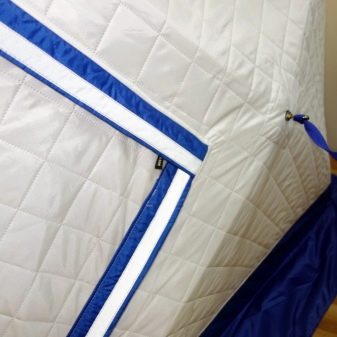
Four-layer
Four-layer tents are made for the toughest fishermen. They are often used by members of expeditions that take place in the harshest harsh conditions, for example, when climbing the highest peaks of the Earth. But even these tents are hardly suitable for Antarctic conditions - much more solid shelter is required here. It makes no sense to increase the number of layers further, since the weight of the product already reaches 20 kg, and such a shelter loses its mobility without delivery to the place by car or motorcycle. Example − "Penguin Prism Siberia Premium": its price reaches 25-30 thousand rubles.
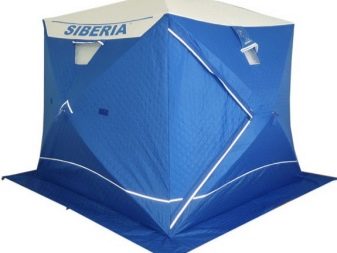

If single-layer tents are suitable for summer and off-season (“cube” can also be used in summer), then two-layer and three-layer tents are suitable for winter conditions. Three- and four-layer are indispensable in winter in the conditions of the Far North.
By the number of places, the tents are designed both for one person and for a group of 2-4 people. This is easy to check by reading the descriptions of tent models from popular companies, as well as by calculating the area occupied by the tent. Quadruple occupies an area of 230 * 230 cm, 3-seater - about 210 * 210, 2-seater - about 200 * 150 and single - about 130 * 130. The latter is not designed for spending the night - it is suitable only for daytime halts and ice fishing, it will be very problematic to fall asleep in it.

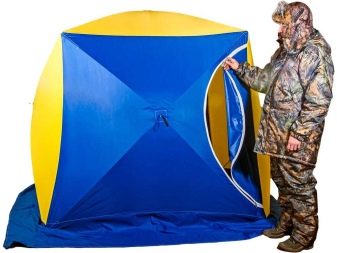
Double "cube" - these are two adjacent "cuboids", a clear distinction between which can be seen from the design. So, the size of a double “cube” already resembles a small room or a service room - the occupied area can be, for example, 4 * 2 m.
A review of Russian tents is not complete without mentioning the products of firms "Bear", "STEK", "Penguin" and "Bullfinch". The last brand in this list is in greatest demand even among polar fishermen: in especially frosty and hard-to-reach regions of the Far North, the three-layer insulated "Bullfinch" will withstand up to 50 degrees below zero. This is an ideal solution to go fishing somewhere in the winter on the Ob or Lena with taste and spacing, or in the fall to go fishing half a kilometer from the shore in the Arctic Ocean, when the ice has gained strength again.
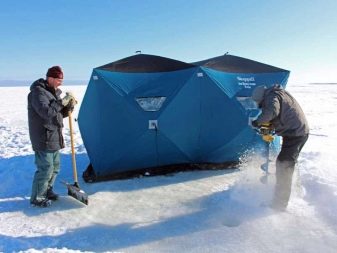

For long winter fishing sessions that also involve spending the night, take a closer look at the varieties of tents that often come with a stove. In addition to the "cube" tents are of the following types:
- Chum tent - a multifaceted umbrella, in design reminiscent of a real hut-tent, popular with the peoples of the Far North. Ideal - in comparison with others - wind resistance, achieved due to the large number of lines (10 or more). It can accommodate a group of 8 people.
- Army - remotely resembles a house with walls and a gable roof. Along with the “cube”, its advantage is a larger volume of the room.
- Shatrovaya - the roof of the tent is similar to a cone, but the walls also remain vertical.
- "Umbrella" - the same chum, only with the walls curved outwards. The basis is two long flexible, elastic guides crossed at the top point of the shelter. But this is not a polygonal supporting structure with beams converging in the center. It is the cheapest and simplest type of shelter, very popular with cyclists and hikers who wander mainly in the summer.
All these tents are equipped with a stove, designed in advance for quick and high-quality installation.
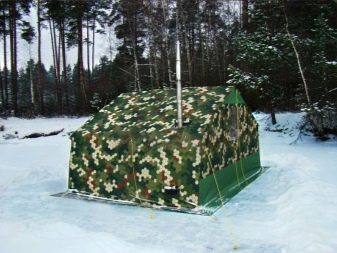
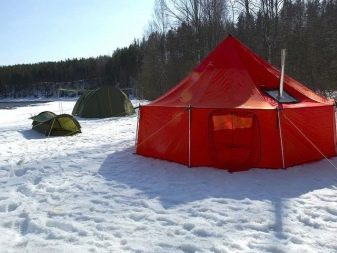
How to choose?
The main criterion for choosing "cuboids" is how many people it is designed for.The dimensions and method of assembly, the mass and quality of materials come to the fore.
The design should be such that one person can handle the assembly and disassembly of the tent - if necessary.. When folded, it should not weigh much, ideally it is transported on the trunk of a bicycle.
Be sure to check not only the possibility of ventilation, but also the presence of micro-ventilation - this will save you from waste in a confined space if not a potbelly stove is used for heating, but a home-made heater without an exhaust pipe.

The dimensions and weight of a tent for winter hiking and fishing are determined primarily by the number of people placed in it, and the characteristic features of the product design. Tents are mainly small (150*150*170 cm), medium (180*180*205 cm) and large (240*240*205 cm) sizes. By weight, they range from 7 to 18 kg.
The product itself must indicate the minimum temperature at which the material from which the outer awning is made will not lose its properties for at least a year. Expensive and most frost-resistant tents are designed for tens of degrees of frost.
Guy wires should ideally be fixed at the attachment points of the pegs. If the seats of both do not match, the panel will simply begin to tear after a couple of dozen installations.

In terms of light transmission, it is light (ideally white) tents that are better suited. In summer, a single-layer white cube will protect you from the heat in the South and the Volga region, when you fish not on ice in winter, but in the warm season on the banks of a river, lake or sea.
On a winter day, when the weather is clear despite frosts, the dark tent heats up from direct sunlight to +30, which will give you significant savings on heating the air inside.Yes, and snowmobilers will not crash into you - the multi-colored and bright colors of the tent will stand out against the background of ice and snow. Choose the option that suits your situation.
Two doors are not only a safety requirement, but also comfort. When the wind changes to the opposite, it will be easier for you to get to the other side of the cover without reinstalling it.
The weight of the product is of no small importance - especially in winter, when you have to walk to the fishing place. Carrying a “heavyweight” of 18 kg, even on your back, is not the best way: you can hardly do without some kind of transport here. If possible, choose the lightest tent possible..
A bottomless tent is only suitable if you have a minimum of fishing gear, and the fishing session itself will not last longer, especially when you know for sure where the most fishing spots are. If you have to spend the night, you should take care of the insulation in advance and choose a tent with a bottom and a windproof edging so that you don’t have to sleep on bare ice or frozen ground.

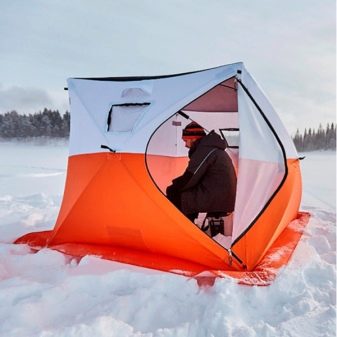
Subtleties of use
The deployment of a tent with an automatic frame assembly system is carried out only according to the instructions. By following it, you can set up a tent alone in a few minutes, even in winter with strong winds. Tent "cube" in its parameters is suitable for severe frosts.
The number of reference points is normally 4-6, additional ones can be purchased separately. In a light wind or no wind, four is enough - but in a storm or hurricane, it is advisable to use all six. The rules for the arrangement of protective shelters require two independent entrances, as well as at least two window openings.
The structure of the shelter with a single layer (the inner tent is also the outer one) has a minimum weight for a "cube", which makes it possible for a tourist or traveler to carry this tent on a bicycle trunk.
But the summer, or lightweight modification of the product is not suitable for a long session of fishing on ice in severe frosts (20 or more degrees below zero) - you will simply get hard there, and there will be “sweat” on the inner surface of the tent and from time to time dripping “room rain” wet your clothes.

An overview of the winter tent "cube" for fishing, see the following video.






















